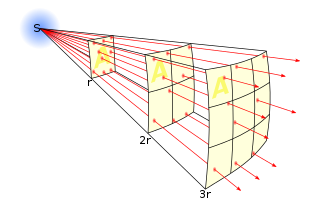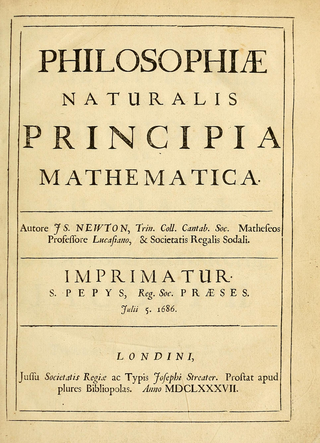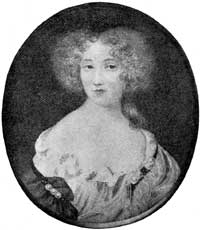Related Research Articles

Sir Isaac Newton was an English polymath active as a mathematician, physicist, astronomer, alchemist, theologian, and author who was described in his time as a natural philosopher. He was a key figure in the Scientific Revolution and the Enlightenment that followed. His pioneering book Philosophiæ Naturalis Principia Mathematica, first published in 1687, consolidated many previous results and established classical mechanics. Newton also made seminal contributions to optics, and shares credit with German mathematician Gottfried Wilhelm Leibniz for developing infinitesimal calculus, though he developed calculus years before Leibniz.

In science, an inverse-square law is any scientific law stating that the observed "intensity" of a specified physical quantity is inversely proportional to the square of the distance from the source of that physical quantity. The fundamental cause for this can be understood as geometric dilution corresponding to point-source radiation into three-dimensional space.

Philosophiæ Naturalis Principia Mathematica often referred to as simply the Principia, is a book by Isaac Newton that expounds Newton's laws of motion and his law of universal gravitation. The Principia is written in Latin and comprises three volumes, and was authorized, imprimatur, by Samuel Pepys, then-President of the Royal Society on 5 July 1686 and first published in 1687.

Robert Hooke was an English polymath who was active as a physicist, astronomer, geologist, meteorologist and architect. He is credited as one of the first scientists to investigate living things at microscopic scale in 1665, using a compound microscope that he designed. Hooke was an impoverished scientific inquirer in young adulthood who went on to became one of the most important scientists of his time. After the Great Fire of London in 1666, Hooke attained wealth and esteem by performing more than half of the property line surveys and assisting with the city's rapid reconstruction. Often vilified by writers in the centuries after his death, his reputation was restored at the end of the twentieth century and he has been called "England's Leonardo [da Vinci]".
Duke of Newcastle upon Tyne was a title that was created three times, once in the Peerage of England and twice in the Peerage of Great Britain. The first grant of the title was made in 1665 to William Cavendish, 1st Marquess of Newcastle upon Tyne. He was a prominent Royalist commander during the Civil War.

Margaret Cavendish, Duchess of Newcastle-upon-Tyne was a prolific English philosopher, poet, scientist, fiction writer and playwright. In her lifetime she produced more than 12 original literary works, many of which became well known due to her high social status. This high social status allowed Margaret to meet and converse with some of the most important and influential minds of her time.

Joshua Barnes FRS, was an English scholar. His work Gerania; a New Discovery of a Little Sort of People, anciently discoursed of, called Pygmies (1675) was an Utopian romance.
The year 1623 in science and technology involved some significant events.
The year 1673 in science and technology involved some significant events.
De motu corporum in gyrum is the presumed title of a manuscript by Isaac Newton sent to Edmond Halley in November 1684. The manuscript was prompted by a visit from Halley earlier that year when he had questioned Newton about problems then occupying the minds of Halley and his scientific circle in London, including Sir Christopher Wren and Robert Hooke.

Henry Cavendish, 2nd Duke of Newcastle upon Tyne, KG, PC, styled Lord Henry Cavendish until 1659 and Viscount Mansfield from 1659 to 1676, was an English politician. He sat in the House of Commons from 1660 until 1676, when he inherited the dukedom.
1666 in England was the first year to be designated as an Annus mirabilis, in John Dryden's 1667 poem, which celebrated England's failure to be beaten either by fire or by the Dutch.

The Description of a New World, Called The Blazing-World, better known as The Blazing World, is a 1666 work of prose fiction by the English writer Margaret Cavendish, the Duchess of Newcastle. Feminist critic Dale Spender calls it a forerunner of science fiction. It can also be read as a utopian work.
Events from the year 1661 in England.
Events from the year 1676 in England.
The Duchess of Newcastle or the Duchess of Newcastle-upon-Tyne usually refers to the wife or widow of a Duke of Newcastle. The dukedom became extinct in 1988.

Margaret Holles, Duchess of Newcastle-upon-Tyne was an English noblewoman.
Robert Payne (1596–1651) was an English cleric and academic, known also as a natural philosopher and experimentalist. He was associated with the so-called Welbeck Academy by his position as chaplain to William Cavendish, 1st Earl of Newcastle. The position also brought him a close friendship with Thomas Hobbes.

Margaret the First is a fictional, historical biography written by Danielle Dutton, first published in 2016 by Catapult then by Scribe Publications later that year. Based on the historical figure of Margaret Cavendish, Duchess of Newcastle-upon-Tyne, Dutton weaves an imaginative story about the duchess's extraordinary life.
In 1686, when the first book of Newton's Principia was presented to the Royal Society, Robert Hooke accused Newton of plagiarism by claiming that he had taken from him the "notion" of "the rule of the decrease of Gravity, being reciprocally as the squares of the distances from the Center". At the same time Hooke agreed that "the Demonstration of the Curves generated thereby" was wholly Newton's.
References
- ↑ Dickinson, H. W. (1970). Sir Samuel Morland: diplomat and inventor 1625–1695 . Cambridge: Heffer for the Newcomen Society. ISBN 0-85270-061-X.
- ↑ Wilson, Curtis (1989). "The Newtonian achievement in astronomy". Planetary Astronomy from the Renaissance to the rise of astrophysics: 2A: Tycho Brahe to Newton. Cambridge University Press. p. 239.
- ↑ Fitzmaurice, James (2004). "Cavendish, Margaret, duchess of Newcastle upon Tyne (1623?–1673)". Oxford Dictionary of National Biography . doi:10.1093/ref:odnb/4940 . Retrieved 2011-11-24.(subscription or UK public library membership required)